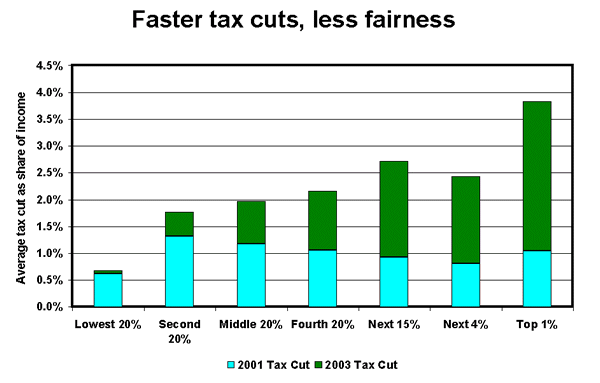Snapshot for April 16, 2003.
Discarding pretense of tax cut equity
The tax cuts passed in 2001 were said to be equal in some kind of proportional sense. The phrase “across the board” was heard repeatedly. When some pointed out the lack of tax relief for lower-income persons, it was said that tax cuts were given to all who paid taxes. This week’s chart-which shows the 2001 tax cuts and the proposed 2003 cuts as shares of income-clearly demonstrates that none of these things are true.

The percentages reflect average tax cuts for different income groups (shown along the horizontal axis). The lower light blue section of each bar applies to the 2001 cuts’ effects on taxes in 2003. These cuts are, indeed, roughly equal in percentage terms. The reason is that the tax law was written to phase in the tax cuts over 10 years. In 2003 the effects will be similar, in terms of the percentage-point change in the taxpayer’s average tax rate.
Now, however, the President has proposed to phase in the 2001 cuts more rapidly and add new cuts. (These are reflected in the green section of the chart’s bars.) It is obvious that the President’s proposal would immediately make the cuts very unequal in terms of percentages. No more “across the board.”
Much of this unevenness would come to pass over the decade under current law. The President’s proposal speeds up the cuts and the unfairness that goes with them. In addition, the newly proposed dividend tax cut adds inequity in the distribution of the tax cuts. By contrast, freezing the tax rates and other provisions as they are would limit the cuts to the light blue bars in the chart.
Source for the data is Citizens for Tax Justice.
This week’s Snapshot by EPI economist Max B. Sawicky.
Check out the archive for past Economic Snapshots.
